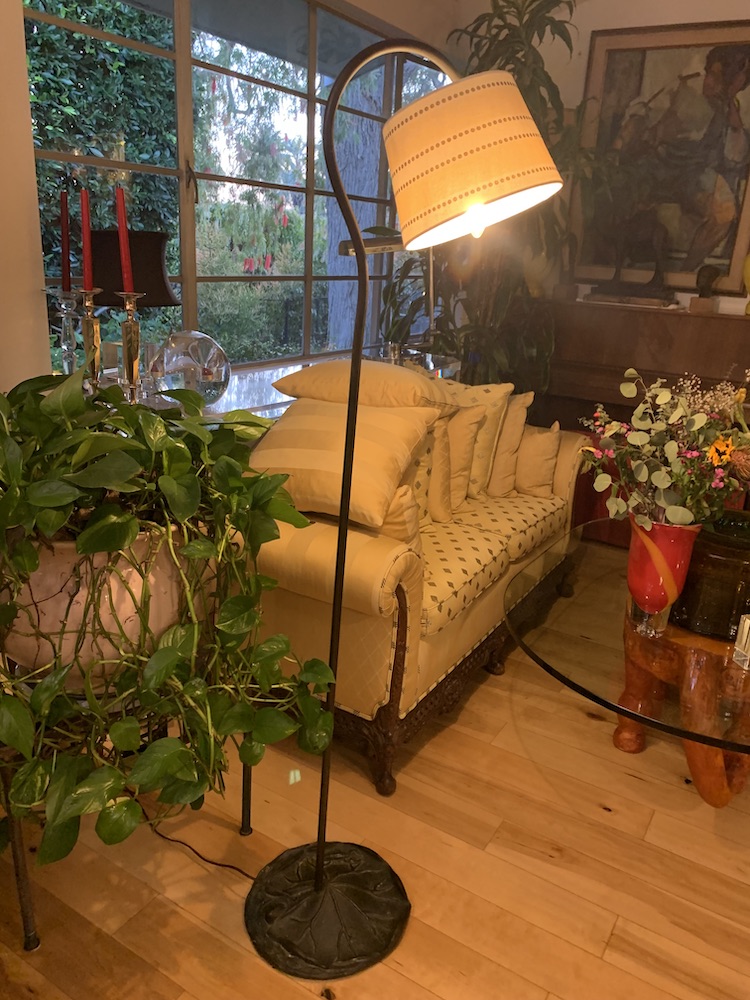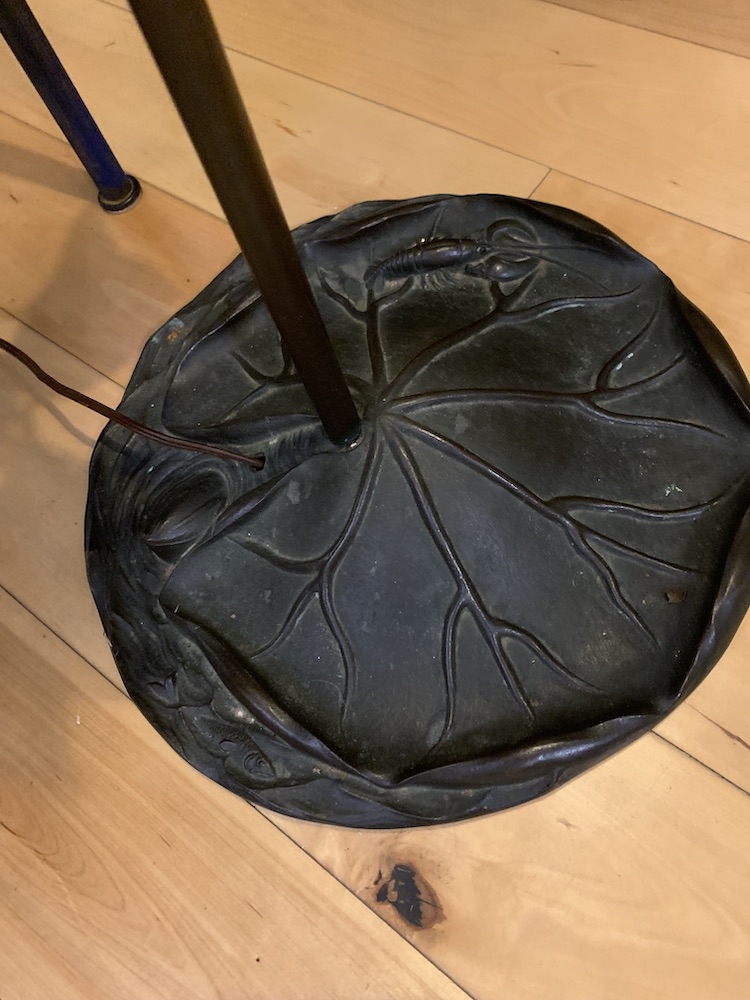Art Nouveau Lamp

JJ has a wonderful goose-neck floor lamp, found at the Earl Warren flea market. The base is a naturalistic bronze – a round figure of a lily pad featuring a little crawfish with tiny minnows. The base is stamped R B and Co., with what appears to be two sets of numbers which likely indicate model.
First question: Was JJ’s find a Tiffany? The lily pad design was a favorite of Louis Comfort Tiffany and his storied Tiffany and Company. If made by Tiffany – the premier designer of lighting in the Art Nouveau style – it would mean this lamp would be valued in the five figures; and that JJ scored. However, no similarly designed bases were found to have been produced by Tiffany.
Tiffany lamps were signed (with a stamp, usually). Apart from that missing identifier, these naturalistic elements of the fish and crawdad on JJ’s lamp are too cute, meaning that the lamp was designed for a less “aesthetically discerning” market than that of the Tiffany buyer of 1900. Tiffany lamps are works of fine art sculpture and have a restraint and dignity to their designs.
Second question: Who was R B and Co.? R B and Co. was the Rose Brothers Company of Lancaster, Pennsylvania. The Brothers manufactured collapsible umbrellas, and for a short time, they were the world leaders in umbrellas. Lancaster, PA, may seem an odd place to have been the center of the umbrella world. Lancaster began in 1729 as a colonial town, and grew to an industrial powerhouse in the late 19th c. The Rose Brothers Company was founded in 1886 by James and David Rose. When they merged in 1890 with Follmer, Clogg, and Co., another umbrella manufacturer, the Rose Brothers built a respectable red brick factory in the Colonial Revival style and began to innovate.
One of the innovations was a 1910 bronze-based lamp that featured a shade that could open and close just like an umbrella. The bases on these ‘umbrella shades’ were produced in the two dominant styles of the day; Art Nouveau and French Classical Revival. If in the Art Nouveau style, the lamp was “themed’’ in such motifs as the lily pad. A Rose Brothers base in the French Classical style would feature a Corinthian column design. The real star of the show, however, was the novelty of the umbrella shade.

naturalistic design
The shades, innovative as they were, caused problems. When “folded”, the umbrella-like mechanism would enclose the radiant light bulb in a way that gave the lamps something of a reputation as a safety hazard. JJ’s floor lamp has no trace of its former shade, but the base is interesting and clever; an affordably American Art Nouveau creation for the lower brow collector.
Two technological events occurred between 1890 and 1910 which made Art Nouveau the language of lighting. Firstly, great glass and furniture designers took notice that interior lighting could be a completely new field for design. The first incandescent lamp was not produced till the early 20th c. Designers working in glass took special notice, because the brightness of the bulb meant that a colorful and glowing glass shade could be a room’s focal point.
Designers in Europe, where Art Nouveau was born, were responsible for the revolution in Art Nouveau lighting – alongside one notable luxury design house in America. French artist Louis Majorelle, known for furniture and architectural details, created wonderful sculptural bronze bases, and Emile Galle – an exceptional glass artist in the first quarter of the 20th c. – made wonderful shades. Louis Comfort Tiffany, though, was the major force in fine decorative lighting in the U.S.
Compare the base on JJ’s lamp to a description of lamps which have recently sold in the genuine “high style” of Art Nouveau lamps. First, we have an early 20th c. American floor lamp whose bronze stand takes the sculptured form of river cattails and scrolling vines, which continue up the lamp to the terminal of bronze flowers. This is a good example of how nature inspired lamp designers of the day, as they realized the aesthetic opportunities made possible by the new electric light bulb. This American lamp sold for $1,500.
Second sale – Emile Galle’s 1909 floor lamp comprised a bronze rendition of a rose and thorn tree, replete with blossoms and branches, and painted with enameled colors. Galle designed this vine stem floor lamp with true-to-nature roots as the base. Two of these lamps sold recently for $20,000 for the pair at auction, but other sets can be seen in the Musée d’Orsay in Paris, and the MMA in NYC.
The value of JJ’s floor lamp is $500.






